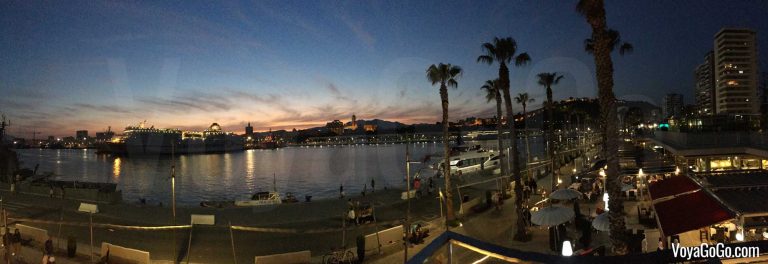
Malaga City is one of my favourite European destinations for a short break to recharge and experience a different culture. Why? Mostly the ease. It’s just so straightforward. That’s important for short getaways. If you spend a day getting there and a day getting back it can become a slog.
Throw in the fact that you can get a cheap flight, a value hotel, great weather, culture, alongside fab food and drink, and it ticks all the boxes.
Getting Into Malaga City.
One of the most surprising things you’ll notice when you arrive at the airport train station, is the number of Brits waiting for the train going the other way. You’ll convince yourself you’re on the wrong platform. For many, “Malaga” is just an airport, with the vast majority heading along the coast to places like Fuengirola, Benalmadena and Torremolinos. Malaga City is often overlooked.
For a trip with a bit more culture and all things Spanish, then Malaga City is the direction to head.
The airport train station is metres from the terminal. Look for the red “Cercanias” signage. The urban railway system will get you into central Malaga cheaply and swiftly (in just 14 minutes). There’s a train every 20 minutes from early morning to late night.
Am I making a meal of the transport? Possibly. I tend to think the logistics of getting to and from your holiday destination are the most stressful. Knowing that it’s that easy can make all the difference. It’s almost as if you take a deep breath at your departing airport, and don’t fully exhale again until you bounce on the bed at your hotel.
The Hotel.
My hotel of choice for all 3 of my visits has been the Ibis Malaga Centro Ciudad. I’m a fan of value, but clean and well presented hotels. I don’t need a chocolate on my pillow or over the top luxury, but I need to know it’s going to be clean and presentable with all the usual facilities. The standard level Ibis Hotels (those with the red logo) tend to meet that need for me. It’s also quite handy for that train line, at about 10 minutes walk max from Málaga Centro Alameda. Of course there are cheaper and also more up market alternatives. The Ibis hotel is located next to the Guadalmedina, which is technically a river, but spends most of its time dry. There is a footbridge adjacent to the hotel, giving just a 6 minute walk to Calle Larios, Malaga’s main shopping area in the historic old town.
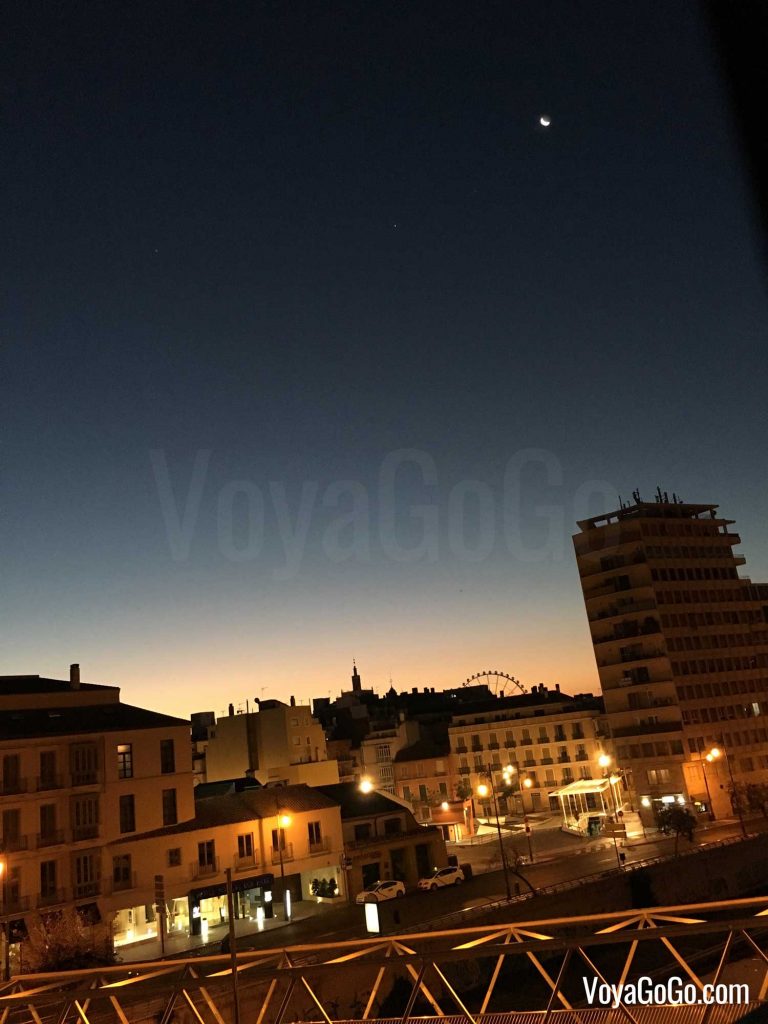
All this means that I can get on a 3pm flight in Leeds, arrive in Malaga 2-3 hours later and be in my hotel in less than another hour. Allowing another hour for the time difference, I can be sat in a restaurant by around 8pm local time. There aren’t many destinations that are this easy. No extra transfers. No expensive taxis. Just fast, efficient transport.
Another reason I love Malaga is the consistency of the weather. I was able to sit at a table outside an Indian restaurant, just a couple of days before Christmas, and enjoy a great curry while the digital sign opposite told me it was 22 degrees celsius. For a British northerner, that’s like the height of summer. Of course, weather is never guaranteed, but I’d say you’d be very unlucky to get it bad here.
Malaga city is also quite compact. Of course, the entire city spreads out, but in terms of where you’ll visit as a tourist, it’s quite a small footprint. It takes in the ‘old town’, the port area – Muelle Uno (refurbished in recent years) and the city beach, Playa de la Malagueta.
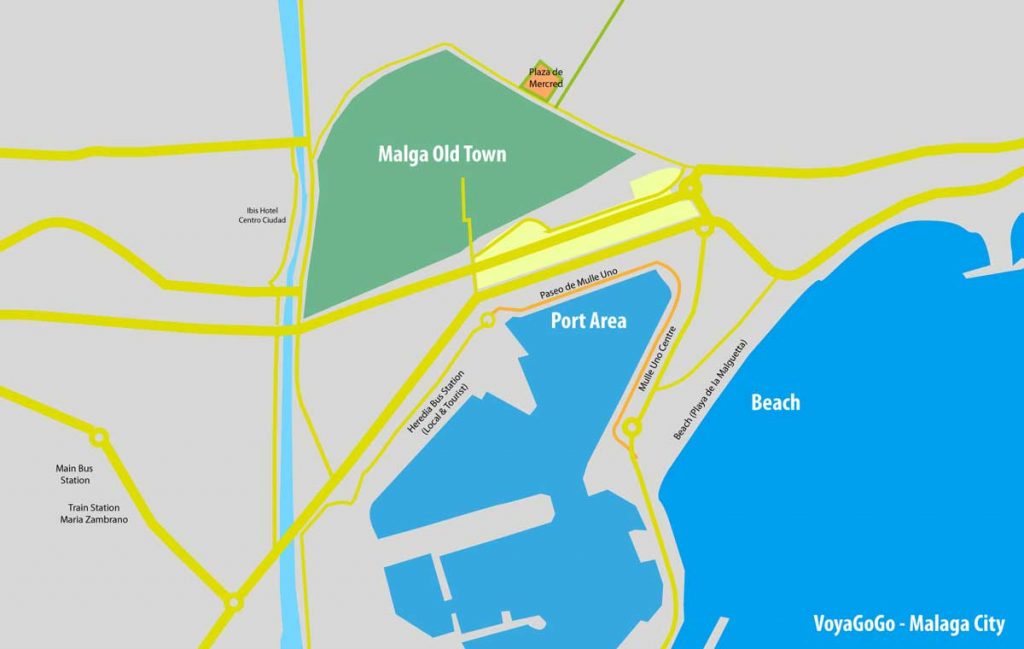
Malaga Old Town.
If you love that Mediterranean old town feel, you’ll fit in here. Narrow, mostly pedestrianised, little streets, where you sometimes feel you could stretch out your arms and touch both sides. It means you get the whiff of all the cafes and restaurants you walk past, and can touch most of the merchandise without actually going into the shops. Eventually they blend into some of the many larger plaza squares and shopping streets.
The principal shopping street is Calle Larios (or Calle Marqués de Larios to use it’s full name). You can lose yourself in a bunch of high street names, find a place to eat, or get one of the best ice creams in town and take a seat to watch the world go by. The ice cream place is called Casa Mira. When it’s busy, which can be often, there’s a strange little ticket system where you take one as you enter and they serve in order.
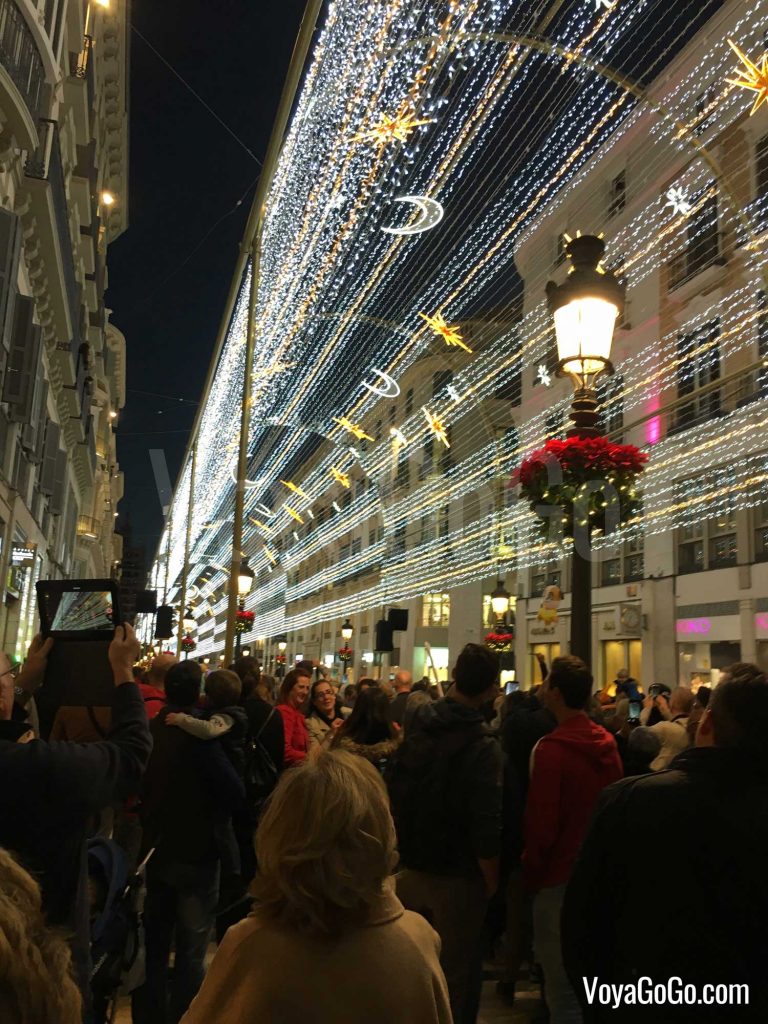
Joining Calle Larios is the Plaza de la Constitución. This is a square where many of the cultural events are held. If you go at Christmas, you can catch the nightly light displays that take place.
In fact, there are many squares and places just to hang out and take in the city. I loved the area around Teatro Romano de Malaga. It’s the remains of a 1st century Roman amphitheater which lay hidden for centuries. It was only rediscovered in 1951 when nearby work uncovered remains. Today with it’s museum, it frames the adjacent avenue which appears to have become a bit of a meeting point for many. Just opposite is the renowned El Pimpi restaurant, one the most popular restaurants in the city. You can also skip the food if you prefer, and make your way into the little traditional bar at its inner sanctum.
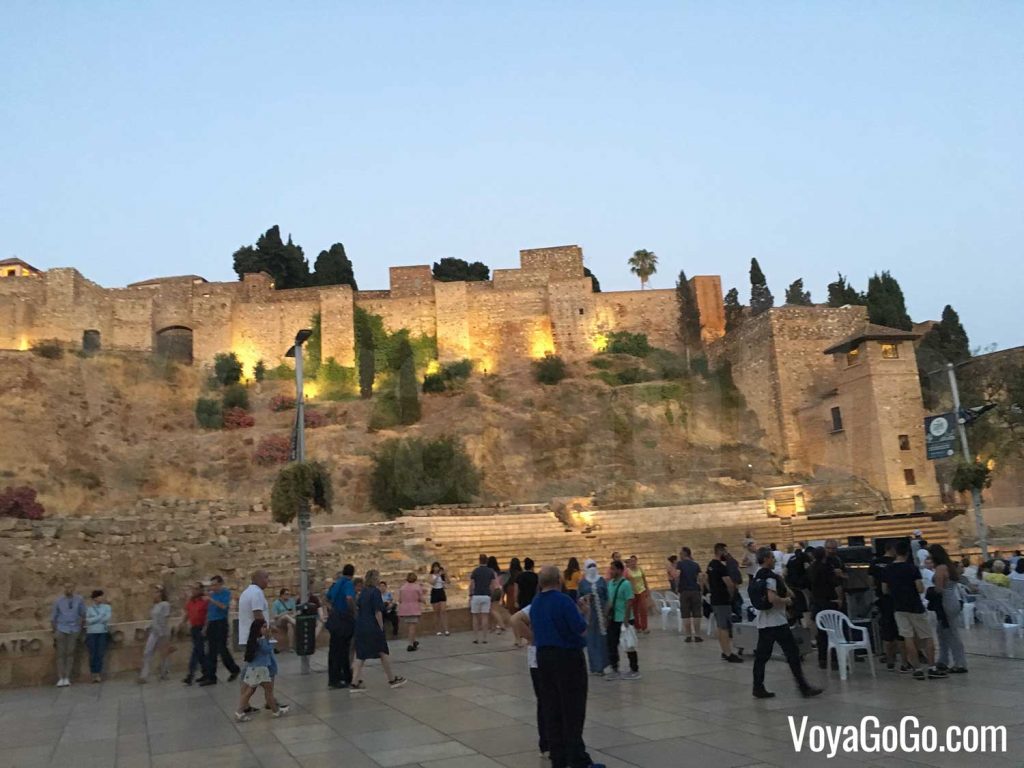
History To See In Malaga.
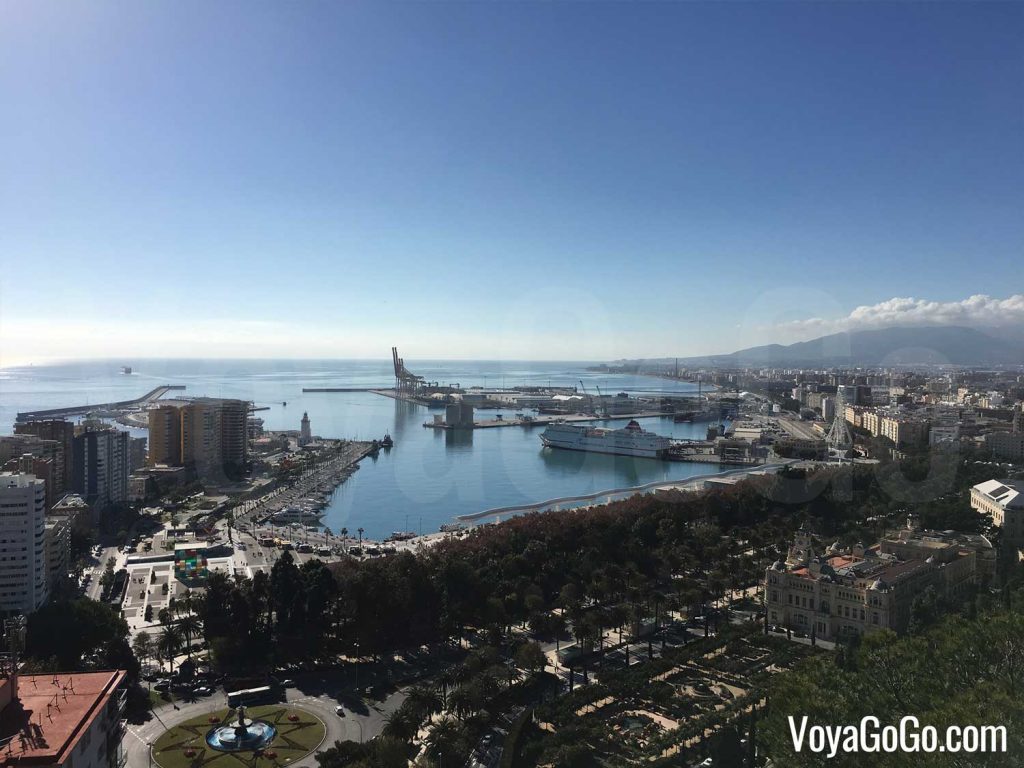
In terms of historical sites and venues, Malaga has quite a number. If you only do one or two, I would take in Gibralfaro (Castillo de Gibralfaro), which is the castle on the hill overlooking Malaga. The views are amazing looking down on the Port, the Bull-ring, the urban Parque in one direction, with a view over the rooftops of the city when looking the other way.
A Cheat for Castillo de Gibralfaro.
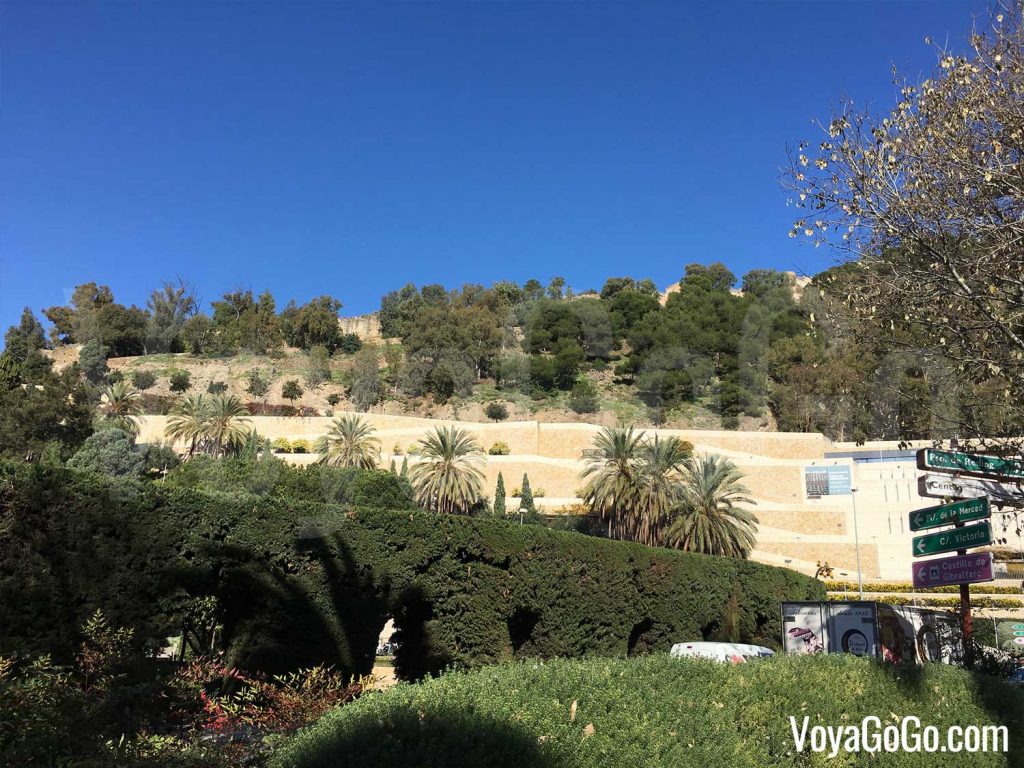
Now, the first time I did this trip I nearly killed myself walking up the path in the heat. It’s quite a climb. The absolute kick in the shins was reaching the top and seeing a bus pull up just outside with a bunch of fresh faced, non-sweaty tourists getting off. Bus number 35. You’re welcome. It runs along the main Paseo del Parque through the centre of town. Save yourself the grief. Bus up. Walk down.
Malaga’s Alcazaba.
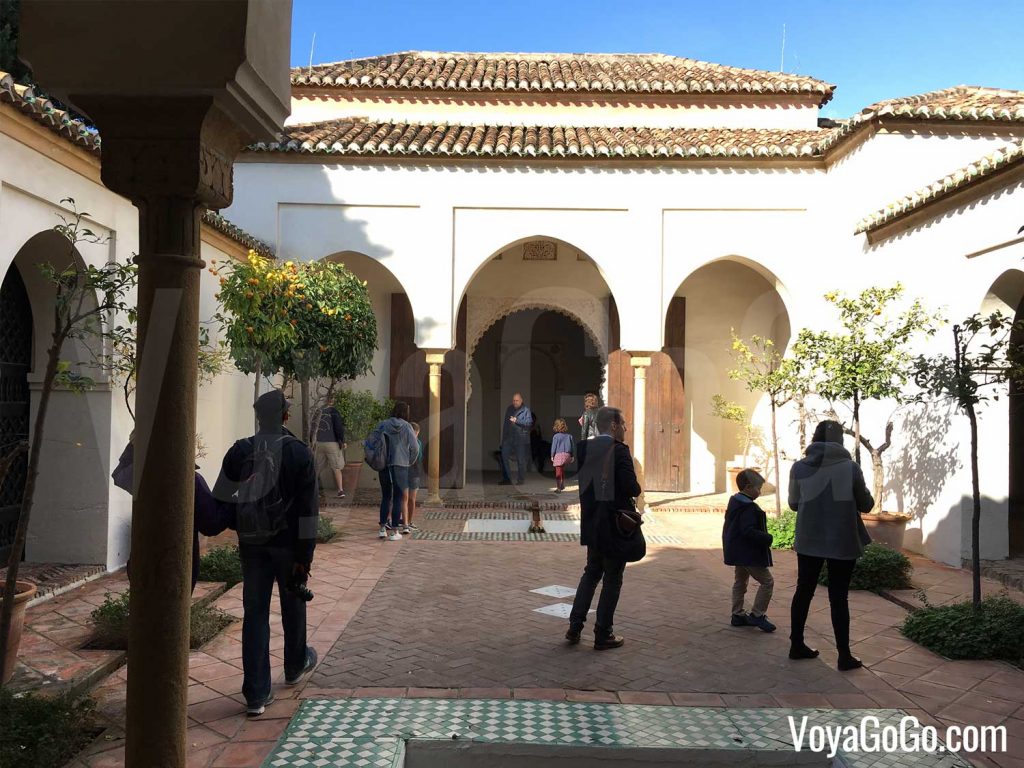
Very close to Gibralfaro is the Alcazaba, which is a medieval Moorish palace. I’m not going to pretend it’s anywhere near as good as the jaw-dropping Alhambra in Granada, but it has beautiful gardens and architecture, and views. It has a similar feel, but on a much, much smaller scale.
At my time of visiting, it was possible to get a double ticket for both Gibralfaro and Alcazaba. It’s only a few euros anyway, but you can save a little by asking for this.
Parque de Malaga (Malaga Park).
One of the surprises of the city is it’s urban park, El Parque de Málaga, which dates back to the late 1800s. As you cross over the road from the old town and head in the direction of the port, you’ll find it oddly straddling the city’s busiest road, laid out in front of the Town Hall. It shouldn’t work in that location, but it does, a kind of urban oasis where you can escape everything else.
I’ll confess I’m not an expert when it comes to plants. There are walkways lined with palm trees, places to sit, and a range of weird and wonderful flowering trees and shrubs from around the world. The park nods to the history of Malaga as a world trading port founded in 1000 B.C. The plants were brought back from locations around the world.
The local birds caught my eye too. Mostly because they screech and are lime green in colour. Malaga was my first encounter with wild parakeets, so I found them fascinating, if not a little noisy.
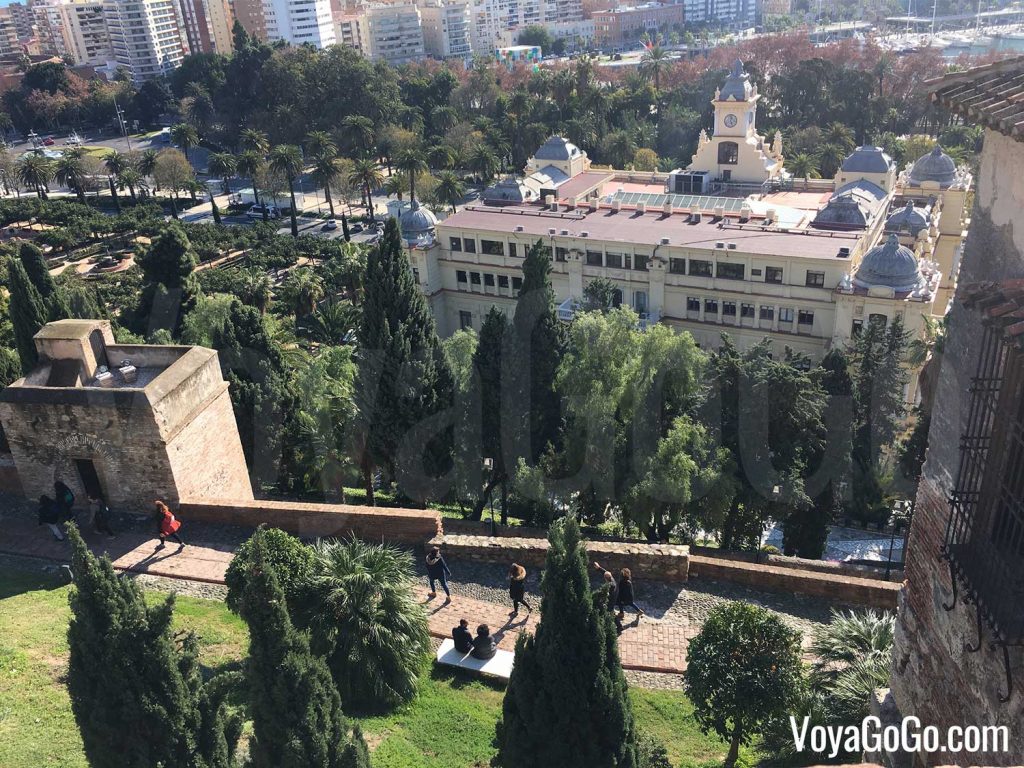
Malaga Port and Muelle Uno.
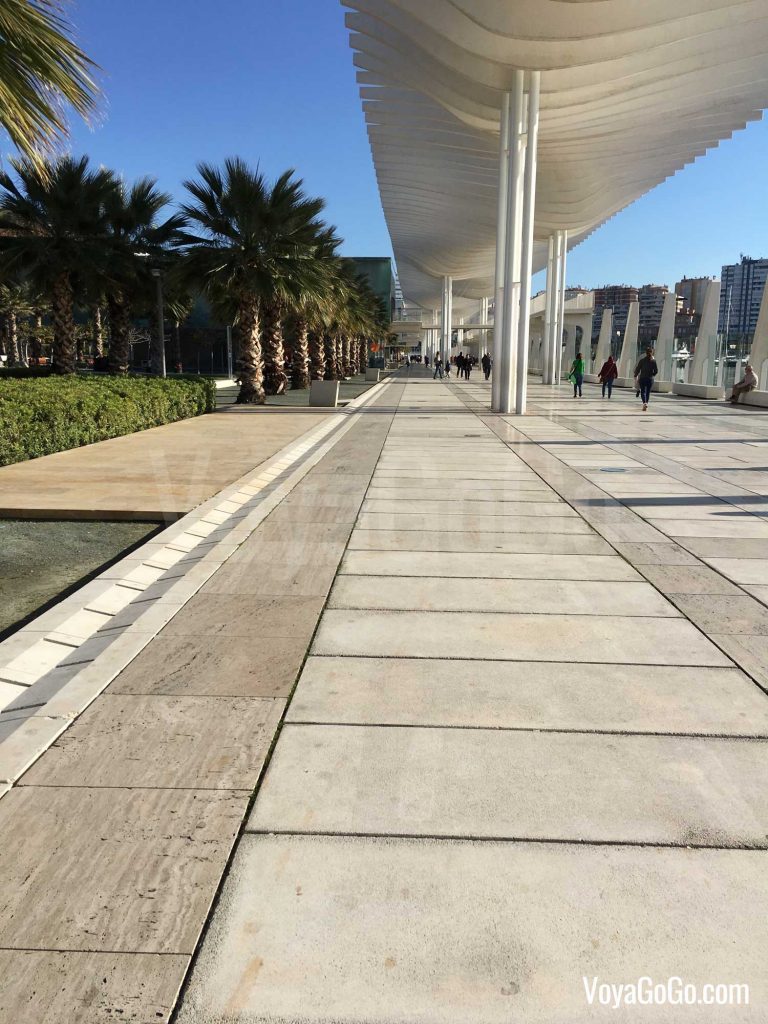
Part of the old Malaga port underwent a major transformation in recent years. The result is a stunning social, shopping and recreational space. Running parallel to the urban park nearby, there is a striking walkway along the portside called Paseo de Muelle Uno. Lined with restaurants and other facilities on one side, and a glass wall to the port on the other, it’s just another perfect hang out spot in this city. At its end, you turn the corner onto the Muelle Uno complex. Described as a shopping centre, it’s mostly outdoors, so not your typical arrangement. Essentially you stroll along the port side with yachts on one side, and shops and restaurants on the other. I mooched about in the warm sunshine of Christmas day, whilst the tannoy played “Baby It’s Cold Outside”. I tittered.
At the end of this section of the port, you’ll find ‘La Farola’. One of Spain’s oldest lighthouses, finished in 1817. Its name literally translates as “The Lampost”.
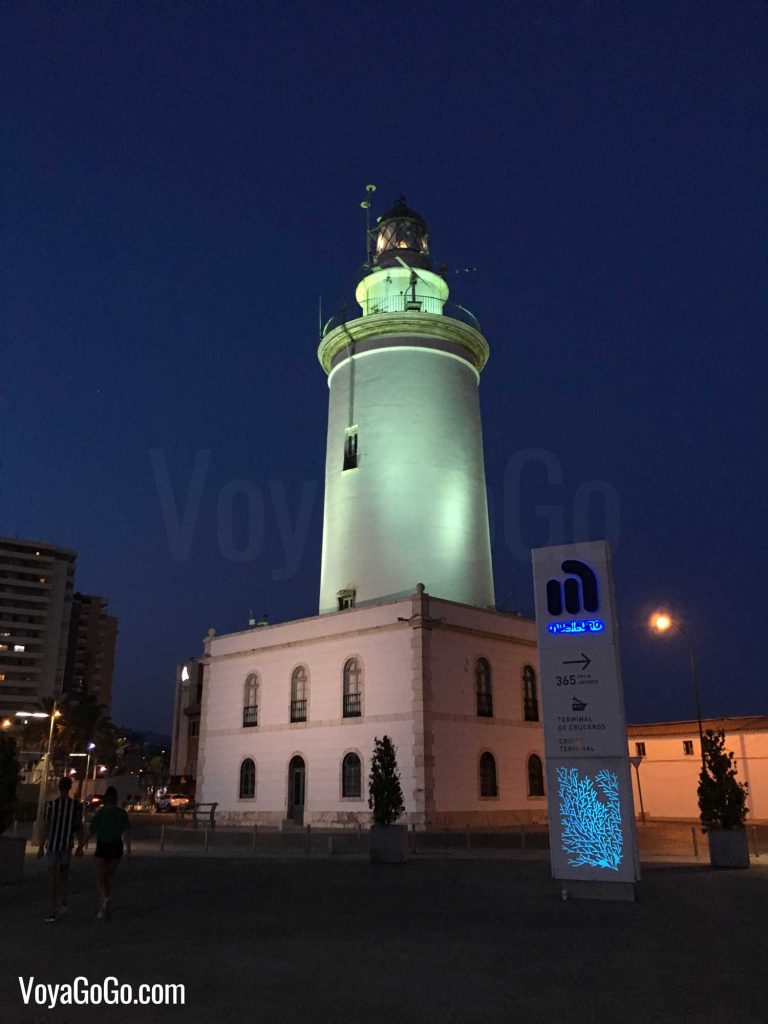
Malaga is also a major stop for many cruises, so it’s not unusual to see a massive ship in port at any time. The remodelling work that has gone on around the port is extensive and the results are fantastic. I love this area of Malaga. It’s hard to believe it only opened around 2011.
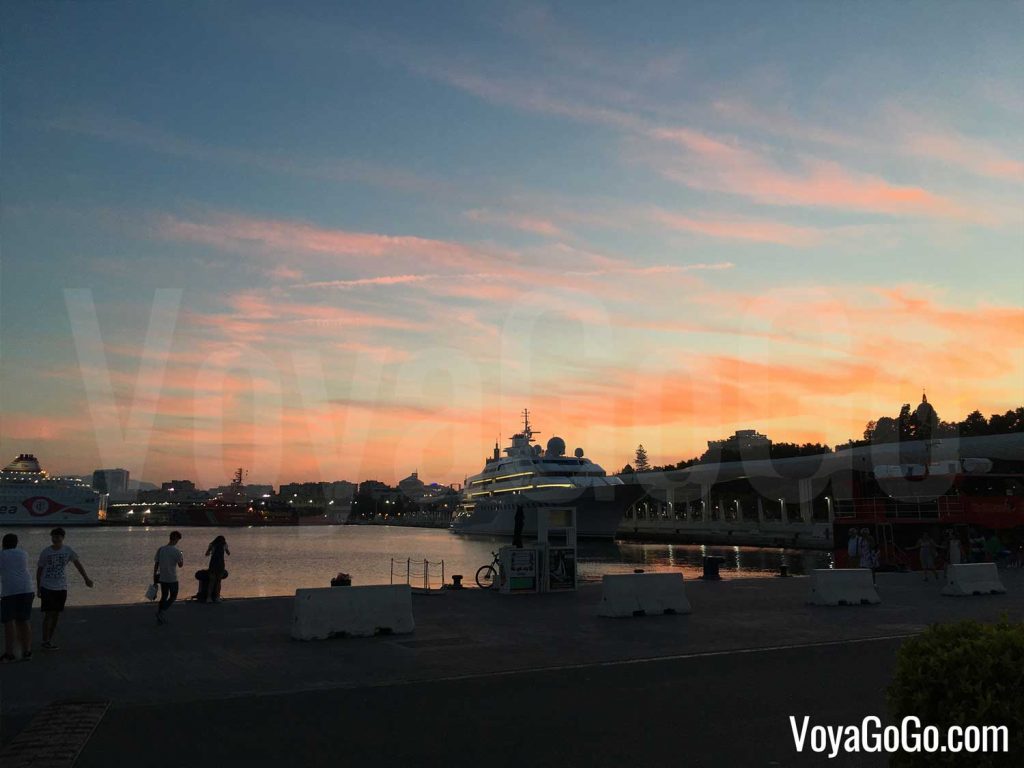
Malaga City Beach – Playa de la Malagueta.
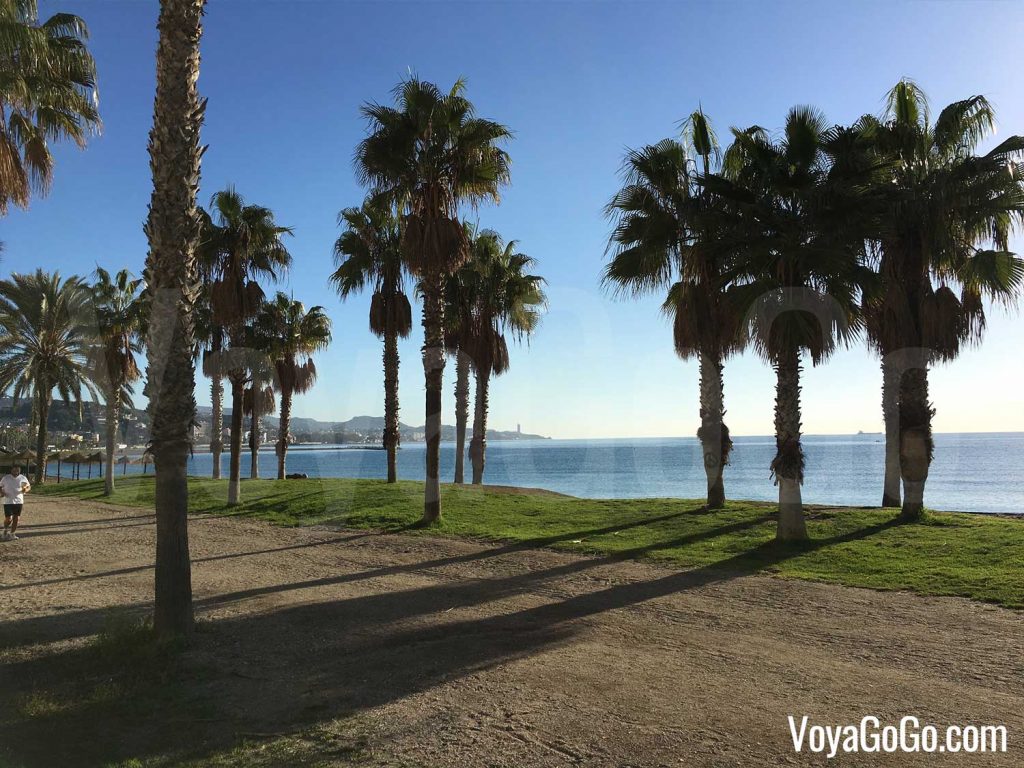
It’s easy think of Malaga as not being a beach resort, but it certainly has one… and it’s pleasant and bijou. It sits just round the corner beyond the aforementioned lighthouse. By Spanish standards it’s relatively dinky at just 1.2km long. That said it has amenities and is lined with chiringuitos. Cafes and shops are just a quick hop. I started this article by talking about the Brits heading the other way to get to the beach. If you’re looking for a two week beach holiday, this one probably isn’t it. If you’re looking for a great city break with the added bonus of a beach thrown in, then this could well suit.
Food in Malaga.
Firstly, there’s lots of it. I’ll confess to being a bit of a fussy eater, so not very adventurous. At least in Spain, tapas presents the opportunity to experiment with small dishes. I surprised myself with anchovies.
As a solo traveller, I’ve found that one of the hardest things to deal with is restaurants. By nature, they are social spaces, and the culture seems very geared towards larger groups, and even if welcome, I’ve felt a bit odd dining alone. I want to eat in nice places, but I’m not one for forcing my way into a rammed restaurant, to demand a table for one. Unless maybe there’s a bar type seating.
If you’re travelling on your own, my advice would be eat earlier – which isn’t hard because the Spanish dine late. Some restaurants won’t open until 8pm. Also, I’d seek out restaurants away from the busiest streets. That way it’s just easier to get a table. I’ve found many good ones just on the fringe of all the action. Clearly you can do some online research to get a heads up on its rating. If you get the urge for something more fast and familiar, then many of the global fast food brands can be found here. KFC, McDonalds and Burger King are all present. Pizzas can be found all over. Sorry, I know I deserve a slap for suggesting these.
This is probably a good time to point out that the ambition of this blog is to help solo-travellers, hence the above. If you’re reading this and not travelling on your own, then the restaurants are throbbing. Go get ‘em!
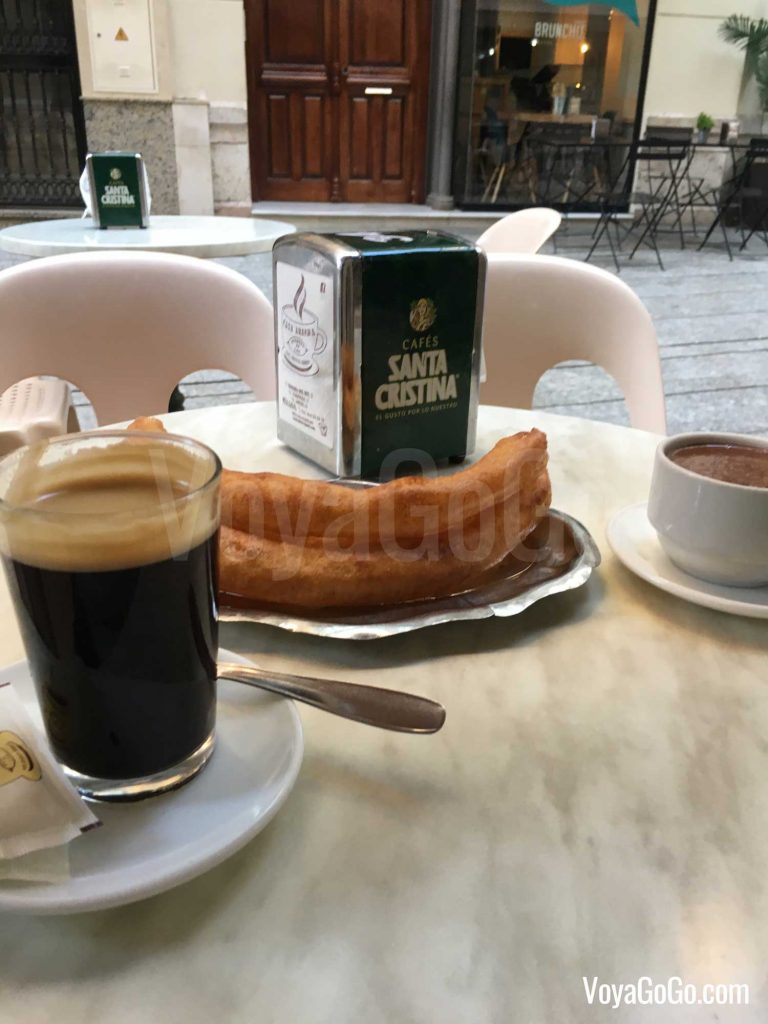
Breakfast is definitely a time where I like to set up for the day. I love my churros and chocolate. A place I’ve returned to each time is Casa Aranda. You can see the man frying and cutting the churros while you wait. You’ll find it down the street from the main market (Mercado Central de Atarazanas), which is incidentally also worth a look. In Moorish times, when the sea came further inland, the market building used to be a shipyard. Architecture with your bag of fruit and veg.
If you go down the ‘Full English Breakfast’ route, then the eggs are great, but ‘sausage’ can be hit and miss. You might even find yourself being delivered something more frankfurter than banger.
Stay Local With The Alcohol.
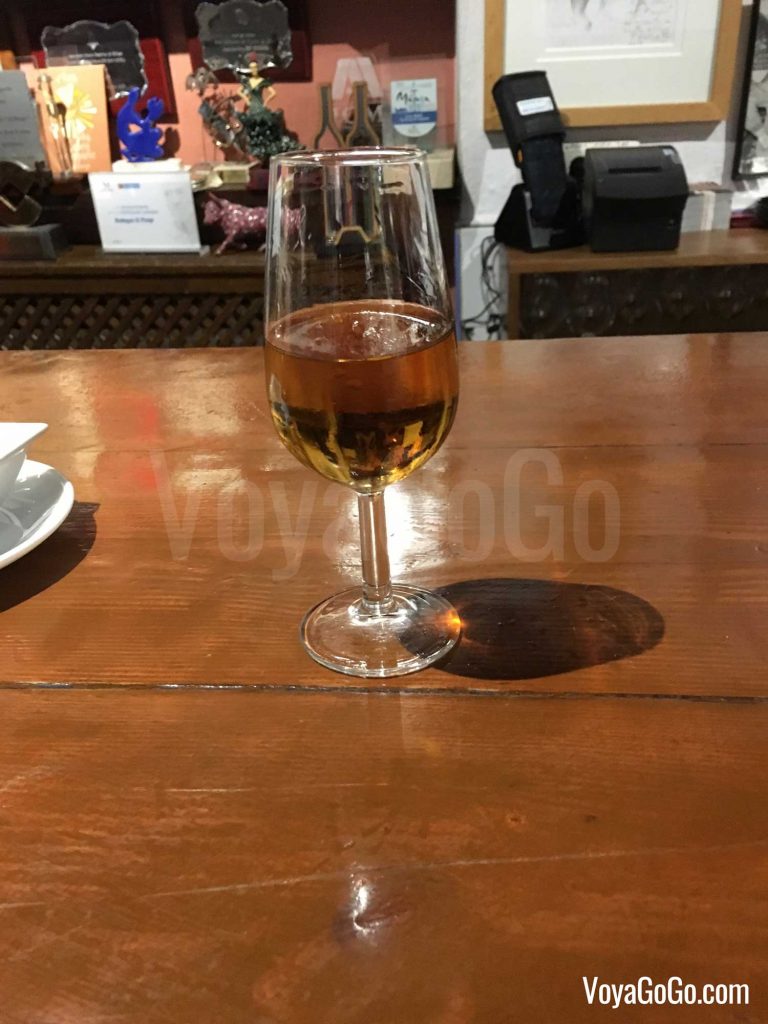
That’s my best advice for a cheap night out. The most local of all is “Pajarete”, a local wine that really falls into the sherry genre to me. You could even try it at Antigua Casa De Guardia, which is the oldest wine bar in the city. I’ll be honest, here I was just ticking a box in being able to say I’d been. It’s quite basic in its atmosphere and layout. There were no seats, just a long bar with a wall of barrels behind. It was quiet. Maybe a crowd would have had a different atmosphere. Good for a couple, but then move on.
One of the great things about drinks in Malaga, (certainly versus the UK), was that spirits and liqueurs were ‘free-poured’ which is to say that measures are generally more generous and often poured at your table. I even had an experience where my particular liqueur tipple ran out mid pour. He went off to get another bottle, while I continued drinking, and then it was topped up 5 minutes later.
Local brands in both beers and spirits will be cheaper and good value. Tap beer will be cheaper. Bottled beers from other countries will be more expensive. The Spanish tend not to drink in pints, like Brits. This is mostly because a cold beer will become decidedly warm unless you drink it very quickly. If you get a cañas (pronounced can-yass) of beer, it’ll probably be around 200ml / half-pint. Often, you might only pay 1€.
Night-Time Vibe.
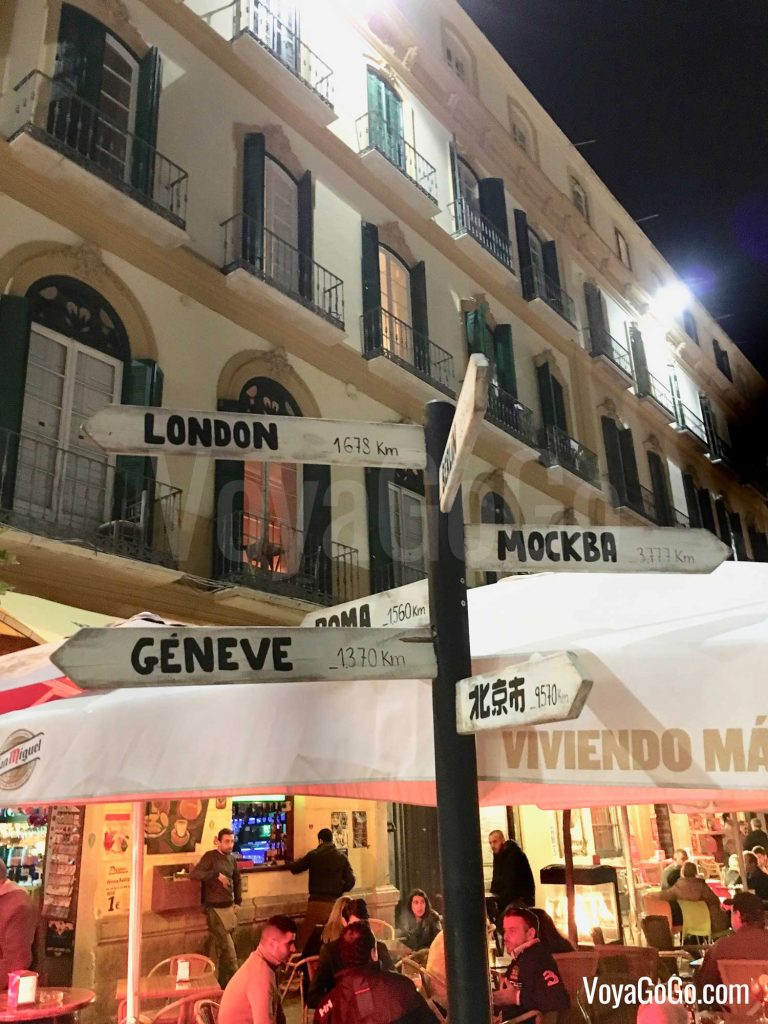
One square that I quite enjoyed at night was Plaza de la Merced. Around the square is lined with bars and tapas eateries that give it quite a nice vibe.
There is also quite a concentrated area of town that appears to have a number of nightclubs and late night venues, in the area south of Calle Alamos (which adjoins Plaza de la Merced) and north of Calle Granada. The northern side of the historic old town.
The Paseo in Malaga.
If you’ve never experienced this, it can take you by surprise. At some point in the mid-evening you think “I’ll take a walk out and see what’s going on”. You then notice the streets are crammed with people walking about. At first, you’re trying to figure out where they’re going. The truth is they’re not going anywhere. The Paseo is just a leisurely stroll. Often, you’ll see families together, coming at you, sometimes 5 abreast and arm in arm! It’s just a social custom. People will stop and chat. Some will have a drink and tapas, as an aperitif to dinner which comes later in the evening.
Watch The Spanish Sunset Over Malaga Port.
If you’re looking for something a bit more up market, with a stunning view, then you could try the AC Hotel by Marriot Malaga Palacio. It’s a 4-star hotel in the centre of Malaga, just across from the park. Even if not staying in the hotel, you can buy a ticket to the roof terrace. Here you can enjoy cocktails and have a first class view of the sun going down. I’ve only heard about this place, I didn’t get to try it personally, but I would imagine you might need to make an effort to dress smartly. In fact, I would say the same for many of the nicer restaurants and venues. At night, your beach wear probably won’t cut it. Gents, pack a pair of long trousers.
Other places to see in Malaga.
Malaga Cathedral (Catedral de la Encarnación de Málaga).
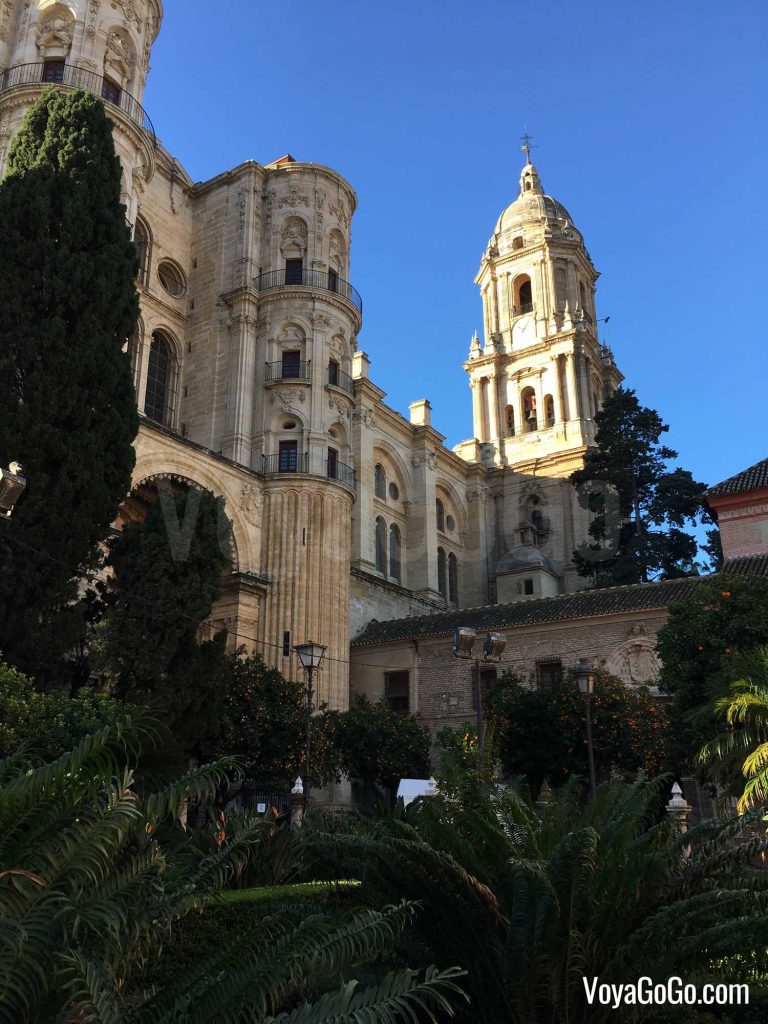
This is a Roman Catholic cathedral in the heart of the old town and close to Alcazaba. It was built during the 16th and 18th centuries. It only has one tower. Legend has it that the funds were spent elsewhere and the second tower was never built. Because of this it has earned the nickname of La Manquita – The One Armed Lady.
Outside this cathedral was the only place in Malaga where I witnessed a “tourist scam” first hand. One of the one’s you read about so often. When the nice old lady tries to press the heather into your hand. Don’t. Walk away. The first part of the exercise is to get you to hold it. Then once handed over, the second part is to insist it’s yours and you should pay the money. Well at least that’s how it’s supposed to work. Unless you want to pay, don’t engage. It’s not aggressive. A firm ‘no’ should do the trick.
Malaga Museum.
The modern day Malaga Museum, formed in 1973, actually occupies the Palacio de la Aduana (Customs Palace), which itself dates back to 1791. The building is modelled on Renaissance Italian palaces, and the museum displays a range of fine art. It is located seconds away from the Roman amphitheatre.
Centre Pompidou Málaga.
Created by an association with the French centre of the same name. The centre is contained in a building called “El Cubo”. Initially a temporary installation, it has been extended until at least 2025.
The centre has a range of permanent and temporary exhibitions and is located at the edge of the Muelle Uno complex in the port.
Kelipe Centro de Arte Flamenco.
Located on the edge of the old town, near to the Guadalmedina, and tucked up a little back street is this Flamenco school and venue for shows. The shows run Thursday to Sunday evenings.
Teatro Cervantes Málaga.
The principal theatre in Malaga, with programmes that include music, theatre, dance, opera, festivals and more.
Malaga City as a base for other travel.
Another bonus of being based in Malaga City is that it is well connected for day trips to other places.
Malaga Bus Station(s).
There are two bus stations. The “estación muelle heredia” near the port. This is for local bus services, but you’ll also find some day trips. In reality this ‘station’ looks more like a long layby with stops. There is signage here and a sales office for the day trips. This location is probably geared up to be handier for visitors arriving on cruise ships.
The main bus station, ‘estación de Málaga’, is located to the west of the city, next to the main train station. This is more of a coach station for longer scheduled journeys and is operated by Alsa.
Malaga Train Station and Cercanias.
The main train station in Malaga is ‘estación de Malaga Maria Zambrano’. It’s actually built into a modern shopping centre. This is where you’ll find all the main train services for Renfe, including AVE.
The one word of warning, is that in Spain, security on trains is more significant than other countries, due to the Madrid bombings of 2004. This means x-ray scanning and airport style security. Allow time for this, because if you turn up 2 minutes before your train, you’ll probably miss it.
The Cercanias is an urban railway, essentially a Metro / Tube type service. The nearest station to the centre is Malaga Centro Alameda. The second station on that line is the main train station should you need a connection. The Cercanias line C1 runs to the airport and down the coast as far as Fuengirola. (There is also a C2 line, which goes inland to Alora, although less frequently).
Days Out from Malaga.
Along the coast.
Taking the aforementioned C1 of the Cercanias urban train, you can get along the coast as far west as the coastal beach resort of Fuengirola. Along its route, this line gives access to the airport, Benalmadena and Torremolinos.
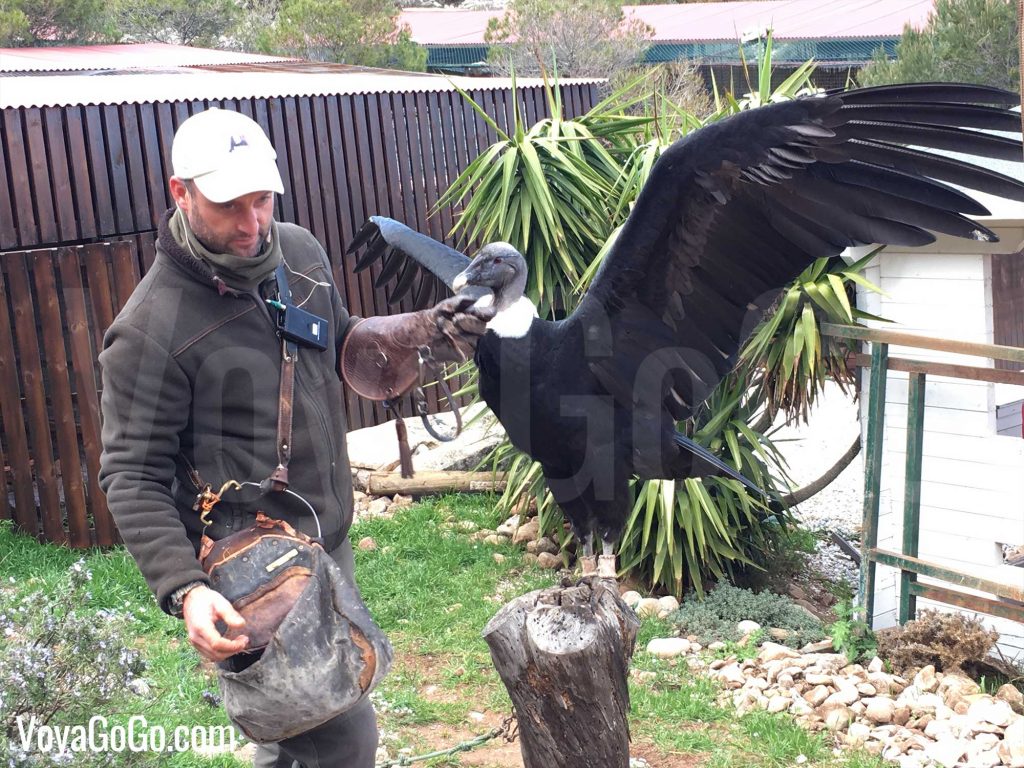
One trip I’d really recommend is the bird show on top of the mountain at Benalmadena. I wasn’t particularly interested in the bird show, but really wanted to go on the cable car which runs from Benalmadena, up the mountain. By chance, my timing coincided with the bird show, which as it turned out, was superb. The show takes place on the top of the mountain, once or twice per day.
Caminito Del Rey.
If you’re up for a more robust trip, I highly recommend the legendary Caminito Del Rey. Even if you don’t recognise the name, you might recognise the picture. It’s a walkway, pinned along the walls of a gorge near to the village of El Chorro. Book in advance and plan your journey. If you’re scared of heights, give this a miss.
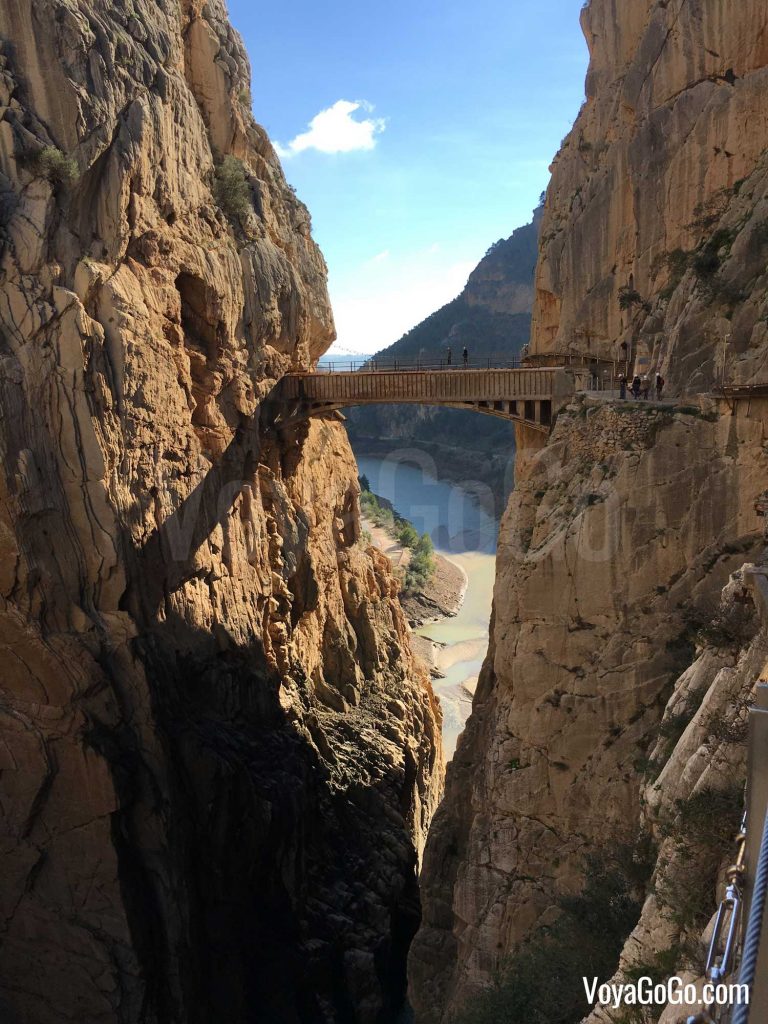
Alhambra in Granada.
The Alhambra in Granada is one of the most visited attractions in Spain. It is spectacular. It is a palace and fortress complex in the city of Granada dating back to 1238. For many, it’s a bucket list visit. You really must book in advance if you plan to go. Getting there is possible by coach from Malaga. (There are also organised trips). I booked tickets with Alsa, the Spanish coach operator and took the coach from the main bus station.
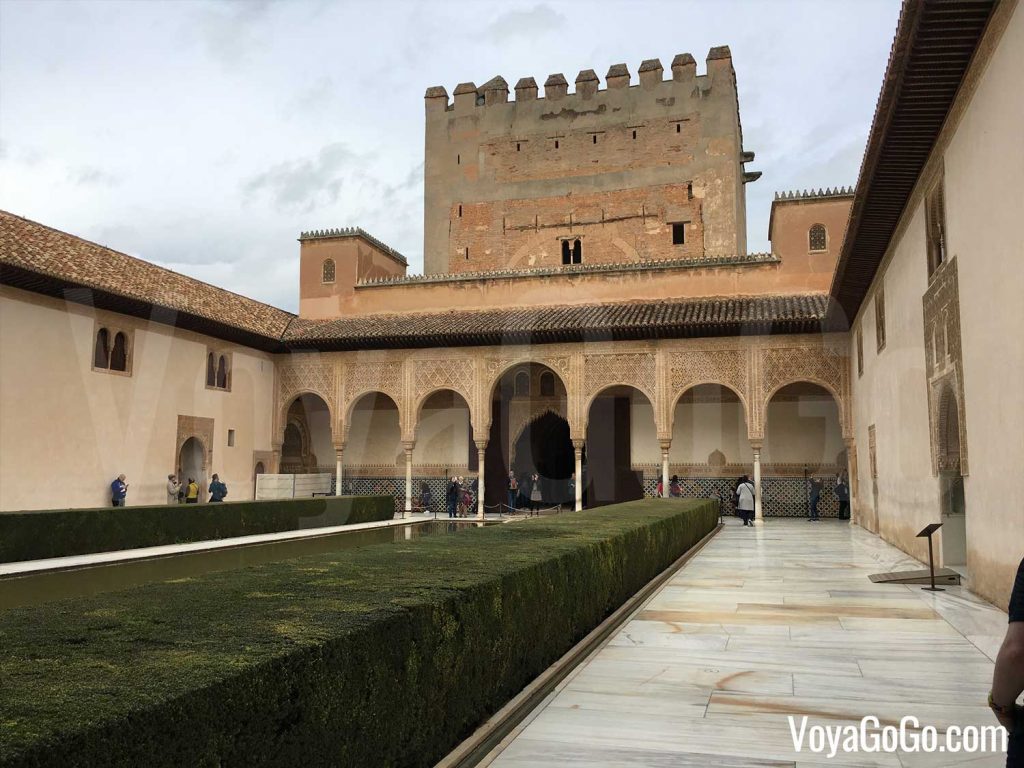
Nerja.
It’s about an hour east of Malaga. Whereas west of Malaga is more Anglicized and ex-pat, going east is more Spanish and more authentic. Nerja is a coastal resort town, with a spectacular Balcon de Europa promenade at its heart. There are bus / coach services that run between Nerja and Malaga.
Ronda.
Another town that is popular to visit is Ronda. It is a mountain top city, sitting above the El Tajo gorge. It dates back to the 15th Century and Moorish rule. The New Bridge (Puente Nuevo) is just amazing. Without your own car, the best way to get to Ronda is probably to book a coach trip which you can do from the ‘other’ bus station in Malaga, Estacion muelle heredia.
Seville (Sevilla)
It is possible to visit Seville whilst staying in Malaga, but the journey time is just under 2 hours by train in each direction, which may be off-putting. I’d recommend saving that for another trip. Check out my travel blog for Seville.
Saying Goodbye To Malaga.
Being a tight Yorkshireman, I like value. Getting your return flight later in the day is ideal to make the most of your trip. Most hotels will hold your luggage for you after check out, so you can squeeze a bit more out of your trip before heading off to the airport.
Whenever I do holidays that involve day trips out to more distant locations in the wider area, I always plan for my final day to be a local one, not straying too far. A ‘mopping up’ day as I like to call it. I once had the experience of a local train strike almost making me miss my flight in France. The stress of that experience taught me a lesson.
Happily, there’s always stuff left to do in Malaga. It’s the sort of place where you leave with a list of things you didn’t manage to get to. That’s okay. It means you’ll come back.
Back at the airport, just outside the Cercanias station, there’s a bank of picnic tables and seats. I found it the perfect spot for rearranging my case, to get all the liquids in the right bag and so on. It’s also the last chance saloon to take in the view. The perfect spot to sit and stare at the mountains and contemplate not coming home.
About The Author

Tony Collins-Fogarty
Solo Traveller
I’ve worked in media for more than 30 years. I embarked on multiple solo overseas trips to attend training courses. Bitten by the bug, I’ve been travelling ever since. This blog is design to offer advice on how to get the best from your trips.

Social